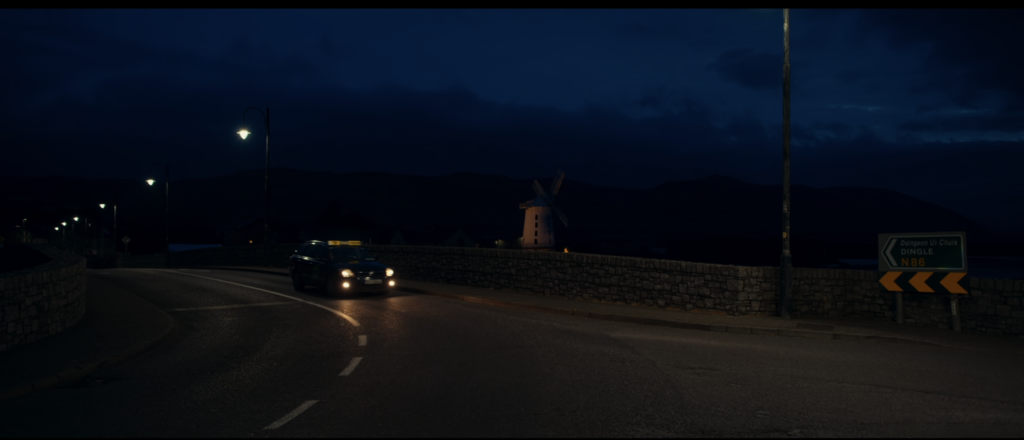Joyride Blennerville Windmill
Muileann Gaoithe Chathair Uí Mhóráin
|
Blennerville Windmill
Address
Eanach, Triúche an Aicme
52.2582059
, -9.7352331

The iconic windmill at Blennerville, just outside Tralee, appears in the background when Mully is driving the stolen taxi. In this instance, like many others in the film, the layout of the journey makes little sense to those familiar with the geography of Co. Kerry. The landscape was chosen for its visual appeal, rather than representing any coherent route through the county.
Joyride is one of three films shot in West Kerry after 2010 (including Run & Jump and Tarrac) that foregrounds inter-related themes of motherhood, loss, and regain. In this case, the immediate experience of becoming a mother is foregrounded. Run & Jump, on the other hand, foregrounds the “being” of motherhood and partnership, and Tarrac addresses the absence of the mother. Yet such motherly absence is also a subtext of Joyride, portrayed in and through the story arc of its adolescent-yet-prematurely-parentified co-protagonist Mully (Charlie Reid), who is a foil for the eponymous character, and reluctant new mother, Joy (Oscar-winner Olivia Colman). The two leads cross paths early in the film, thereafter roaring together across a landscape of fields, hedgerows, and estuaries east and north of Dingle, seeking to escape respectively unsatisfactory familial situations.
For the most part, and much like its aforementioned sister-films Run & Jump and Tarrac, Joyride’s story is presented straightforwardly through dialogue and mise-en-scène. The film is largely bright and high-contrast, a visual theme that is reflected in Joy’s garish costuming. This stylistic simplicity is, however, complicated at certain key points in the film. There is a recurring motif of a monstrous model baby head being towed by tractor across the landscape town-to-town, serving to remind Joy (and the audience) of the inescapable physical and emotional burdens entailed by childbirth. (Joy has just born an unwanted child at the start of the film, and is swiftly thrust into yet another position of pastoral care for the on-the-run Mully – who is actually better suited to parenthood, having largely raised himself after the death of his mother and subsequent neglect by his father.)
The surreal image of a baby’s head traversing the countryside darkly invokes rural Ireland’s – specifically County Kerry’s – tragic history of infanticide, a consequence of Ireland’s regressive policies regarding prenatal and maternal care throughout the 20th century. 1980s Ireland was rocked by a Garda investigation into the murder of a newborn baby found in Caherciveen, just south of Dingle and West Kerry. This still-unsolved murder resulted in the false confession of a local woman whose life was effectively destroyed by misguided legal and medical proceedings against her. In Joyride, the ghosts of these “Kerry babies” are invoked vis-a-vis the image of a baby’s head wandering through – indeed, haunting – the landscape of West Kerry, which is in real life adjacent to the barren strand on which the body of the original “Kerry baby” was found, and perhaps even (in the world of the film) the strand on which Joy’s character, in flashback, is nearly left to drown by her own traumatized mother.
In the here and now of Joyride’s Kerry, Ireland’s traumatic maternal past is not so much comfortably laid to rest; its demons are, rather more, exorcised. This is literalized in the monstrous parade that takes place at the end of the film, the final destination of the monstrous baby head on the tractor. The parade is all earth colours, its players in straw and bone costumes like those seen at Samhain or Wren’s Day in real-life Dingle, spreading out, exploding even, over the shimmering green surface of the West Kerry fields: a grimey (sur)real abutting the visual hyperreality of the Irish idyll. It is in this milieu that the protagonists become mired at the climax of the film, and from which they are birthed anew as a truly 21st century family.
In the video below, screenwriter for Joyride Ailbhe Keoghan discusses her relationship with Corca Dhuibhne, and what inspired her in creating scripts based in this region.

